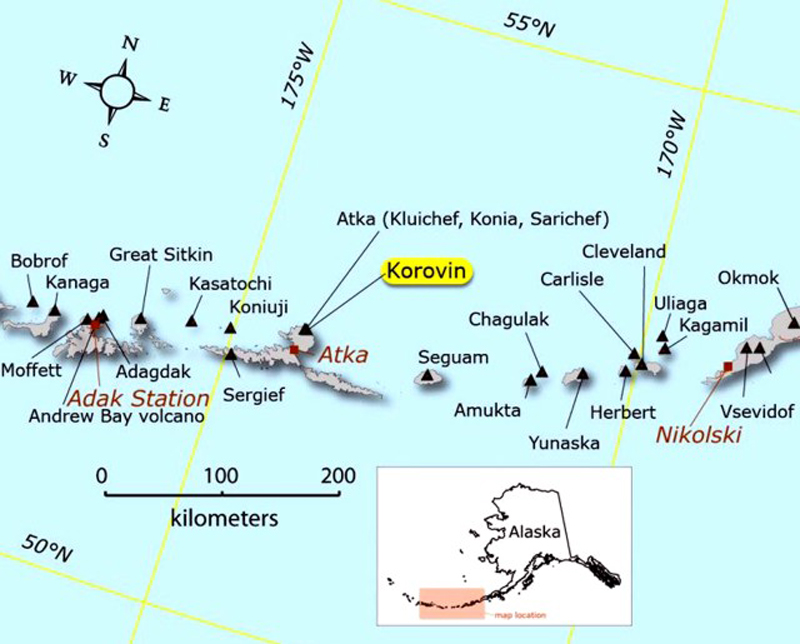Report on Atka Volcanic Complex (United States) — November 2006
Bulletin of the Global Volcanism Network, vol. 31, no. 11 (November 2006)
Managing Editor: Richard Wunderman.
Atka Volcanic Complex (United States) Minor plumes bearing steam and ash throughout November-December 2006
Please cite this report as:
Global Volcanism Program, 2006. Report on Atka Volcanic Complex (United States) (Wunderman, R., ed.). Bulletin of the Global Volcanism Network, 31:11. Smithsonian Institution. https://doi.org/10.5479/si.GVP.BGVN200611-311160
Atka Volcanic Complex
United States
52.331°N, 174.139°W; summit elev. 1518 m
All times are local (unless otherwise noted)
[What follows is a corrected report taking advantage of new information.]
2005 activity. Korovin... has been relatively quiet since 23 February [2005], when it emitted minor though abruptly discharged steam and ash (BGVN 31:02). At that time, an initial ash burst rose to an altitude of ~ 2.4 km and was followed by several smaller ash-and-steam bursts, but no ashfall was reported in Atka village (figure 2). There were no reports of accompanying volcanic odors, earthquakes, or larger volcanic explosions.
Early 2006 activity. Earlier this year, seismicity indicating unrest was noted in January and February (BGVN 31:02). From 24 February-3 March 2006, seismicity at Korovin was slightly above background levels. During that time frame, the Alaska Volcano Observatory (AVO) raised the concern color code at Korovin from Green to Yellow. The concern color code was then but reduced it to Green on 8 March 2006 .
 |
Figure 2. Sketch map of the central Aleutian Islands including Atka Island and the city of Atka (population 27, according to 1999 US Census estimate). Courtesy of USGS/AVO. |
Late 2006 activity. An increase in seismicity during July 2006 represented a transition from prior low activity, meanwhile volcanic activity remained mild during that time (figure 3).
This report also covers further minor events during September through December. During September and October, episodes of volcanic tremor increased in number, strength, and duration. On 28 October, residents of Atka village observed and photographed steam emissions to several hundred meters above the volcano.
For the duration of November and December, seismic levels remained above background levels. In late November satellite information showed a light dusting of ash on the E flank of the main crater along with several plumes and/or their shadows visible along the N side of the crater. Satellite radar images indicated uplift of the volcano; the area of uplift was consistent with locations of earthquake activity and the effects were interpreted as the result of magma injection. Cloud cover permitted only erratic satellite observation during November and December. On 11 and 21 December 2006, Atka residents again witnessed steam plumes, on the latter date possibly containing ash.
Geological Summary. The Atka Volcanic Complex consists of a central shield and Pleistocene caldera and four notable volcanic cones. A major explosive dacitic eruption accompanied formation of the caldera about 500,000 to 300,000 years ago; approximately half of the caldera rime remains, open towards the NW. The Sarichef cone, ~5 km ESE of the caldera rim, retains a symmetrical profile, unlike most other heavily eroded features outside the caldera to the S and W. The Kliuchef stratovolcano grew within the caldera and exhibits five eruptive vents striking NE, including two at the summit, that have been active in the Holocene. A 700-m-diameter crater 1 km NE of the summit may have been the source vent for a large 1812 CE eruption. Hot springs and fumaroles are located on the flanks of Kliuchef and in a glacial valley to the SW. The most frequently active volcano of the complex is Korovin, at the NE tip of Atka Island about 5 km N of Kliuchef. An 800-m-diameter crater on the SE side of the summit contains a deep circular pit that sometimes contains a crater lake thought to be the source of phreatic ash explosions. The smaller Konia cone, slightly offset to the E, lies between Kliuchef and Korovin. Most of the lava flows in the complex are basaltic, though some dacitic flows are also present.
Information Contacts: Alaska Volcano Observatory (AVO), a cooperative program of the U.S. Geological Survey, 4200 University Drive, Anchorage, AK 99508-4667, USA (URL: http://www.avo.alaska.edu/), Geophysical Institute, University of Alaska, PO Box 757320, Fairbanks, AK 99775-7320, USA, and Alaska Division of Geological & Geophysical Surveys, 794 University Ave., Suite 200, Fairbanks, AK 99709, USA.


